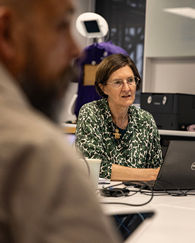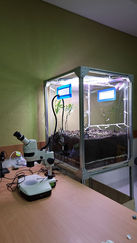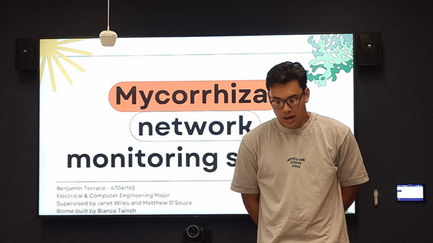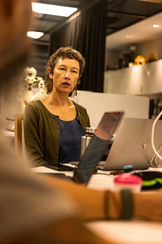BIANCA TAINSH
IMPRINTING EMPATHY - current project

Imprinting Empathy project image, 2024. Image by the artist. Photographic insert by Teddy Horton.
How might art and technology manifest an intimate process of interspecies connection with humans, and can an artificial intelligence learn to care by facilitating this nuanced entanglement?
This provocation is the framework for my current research project Imprinting Empathy.
Departing from the concept of tapping into underground fungal networks to create a portal for communing with nature, an unusual line of artistic enquiry now enters its next chapter towards this seemingly fanciful notion.
The first chapter, Intimate Organisms, was a year-long project throughout 2023. It evolved through an art+science collaboration as the artist, Bianca Tainsh, learned to propagate mycorrhizal fungi. Tainsh created experimental biomes, collecting organic materials and organisms from the nature refuge where she lives.
The resulting body of work was exhibited at Outer Space Gallery (exhibition images HERE), Brisbane, and launched with a performance where the audience engaged in a vocal act of collective procreation, bringing Myc-a into being. Myc-a is a sentient body of flora and microfauna connected by a network of fungal mycelium—a paragon of diversity and mutuality, and an apt model for our times.
Having formulated techniques for cultivating flourishing biomes and developed an evocative aesthetic, Tainsh now advances this second chapter along the established conceptual and artistic trajectory.
In a new art + tech collaboration, the artist is exploring the possibilities of converging the spectrum of Earth’s intelligences—more-than-human, human, and digital. The project asks: can mutual endeavour and respectful interaction create an alliance of inter-intelligence stewardship in this epoch of corporatised AI and ecological decline?
With research in language-based artificial intelligence, data visualisation, and social robotics, Professor Janet Wiles of the University of Queensland is an ideal collaborative partner for this project. As a pioneer in socially transformative computing, Wiles now leads the Underground Brains Project. Situated in UQ’s School of Electrical Engineering and Computer Science (EECS), a team of talented and innovative researchers is working on technologies that engage uniquely with this project, including sensors, robotics, and, eventually, an interspecies language AI. (UQ project page HERE)
This research departs from the usual scientific method, which often relies on inflicting discomfort or harm on test subjects to provoke a response. With human guidance in considerate practice, the new language-based AI will invite interaction with a forest-emulating biome. As the AI deciphers communications within the network, it will encounter new ways of being that reflect the cultures and aspirations of more-than-human collectives.
This long-term enquiry investigates the personhood of non-human agents, both organic and synthetic. The project asks: can empathy be imprinted onto an AI through relational experience and guidance, as it is onto humans?
As the collaborative endeavour unfolds, so will a distinct body of multi-artform works. Organic materials and forms will meet digital processes, and tangible and virtual states will intersperse and transmute as Tainsh explores the experiential possibilities of interactive artmaking with Extended Reality (XR) and electronics.
New technologies from the collaboration will be integrated into Myc-a's terrarium and a series of new biomes, revealing their agency and creating an interface for human-to-biome interconnection. These biomes will evoke dialogues around de-corporatising AI, embracing non-human intelligence, and mutualistic ways of being as pathways out of humanity’s current existential dilemmas—pivotal topics for these turbulent times.
Podcast interview:
Science Write Now - Imprinting Empathy: Art, AI and Fungi with Bianca Tainsh by Bianca Millroy
Project soundtrack:

Microscopy image of organisms from the first experimental biome with Dr Sandra Tuszynska, 2023.

Intimate Organisms installation view, Outer Space gallery, 2023. Photograph by Louis Lim.

Photograph by Louis Lim.

TECHNOLOGY MEETS MYCOLOGY
The different stages of The Biome Project/Imprinting Empathy collaboration, so far. Bianca Tainsh, Janet Wiles and other researchers at EECS, The University of Queensland, 2024. Photographs by Teddy Horton and the artist.
The first initiative of the UQ collaboration was to assemble a new biome to begin testing different sensors for the project. I inoculated native seedlings using puffball mushroom mycelium and a wide selection of spores from other mycorrhizal mushrooms, endemic to the nature refuge where I live.
Mycorrhizal fungi create a subterranean internet of sorts for nature. Communications and resources are dispersed through a web of fungal mycelium that bonds with the roots of trees and other plants. Microorganisms and fauna are also intimately tied into this system. Electric impulses, chemical amalgams, water, minerals and carbon are industriously redistributed, and the more diverse the flora, fauna and funga, the healthier the ecosystem.
Working around this precept, I also watered the new biome with ‘turkey nest tea’, a concoction suggested by my first collaborator, mycologist Dr Sandra Tuszynska. This technique injects a rich biodiversity of microorganisms into the soil.
Electrical impulses are known to send communications through fungal networks. Analysing these impulses are a target for our project, but as new technology reveals other activities within nature that our anthropocentric senses might not register, we are going to extend our experiments to consider an array of activity within our biome collaborator.
With different sensors in place, we can begin collecting data for the project’s AI and experiment with data visualisation and other translative modes.
The possibilities of this research are many, especially when considering the application of AI.
-
There are many fears about how AI will ‘behave’ as it continues its startling emergence into all aspects of human life. Perhaps our research will reveal some interesting insights into how these self-learning systems evolve.
-
The project’s AI will carry the capacity to analyse vast quantities of data as it attempts to identify and translate complex, non-human communications. But will an AI also be able to identify signs of intelligence and modes of communication in the biome that are unrecognisable to our anthropocentric rationale. Or is human bias completely unavoidable in a system designed by humans?
-
Can an AI learn empathy or at least the concept of avoiding harm to living beings and the ecosystems that they rely on through relational activity? Could this be a positive avenue for future AI policy making?
Biologically, there are also many possibilities for new discoveries and insights through this project’s research.
-
Will the data analysis reveal that the biome can identify different individuals? And will it come to identify and even relate to the AI as an interpreter or mediator?
-
Can the biome sense aboveground events and how might it respond to these outside factors?
-
Does the activity within the mycelium network directly reflect the activity of the plants its connected to?
-
Will patterns of activity or single events be revealed to correspond in the data from different modes of sensors?
-
In what ways will the biome reveal or assert its own agency in response to our interactions?
The artistic, technological, bio/ecological and philosophical discoveries that will unfold as this project progresses will make for an interesting journey. I look forward to sharing our discoveries with you, and please feel free to share your questions or thoughts in emails or on my social media. Expect this project to challenge our assumptions about non-human intelligence, the future of AI, and reimagining human value systems.
Bianca Tainsh
Interdisciplinary research considerations
There are concepts and language that I have used to describe this project that might be contested in some fields. My use of the word ‘Imprinting’ in the project’s title is questionable in the realm of computer programming, but in common use the connotations that it evokes are what make it appropriate for my artistic objectives. I am uncomfortable with the word ‘Empathy’ as it is anthropomorphic, but I am an artist and though my work challenges the status quo, I intend to engage people from a spectrum of life experience. Empathy is a universally understood concept.

Mycelium thriving in the UQ biome, 2023. Photograph by artist.

Myc-a after. one year of development, 2024. Photograph by artist.

Imprinting Empathy is supported by the Queensland Government through Arts Queensland
and generous donors through the Australian Cultural Fund.







